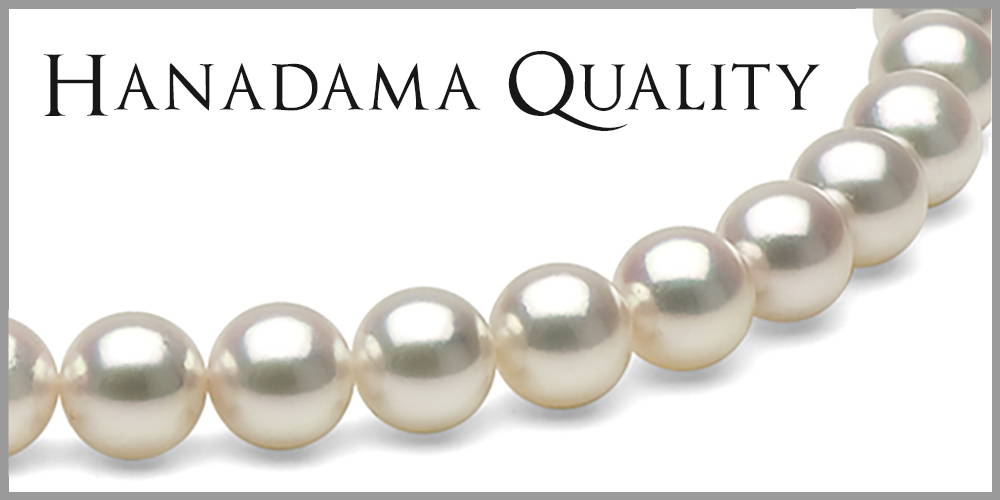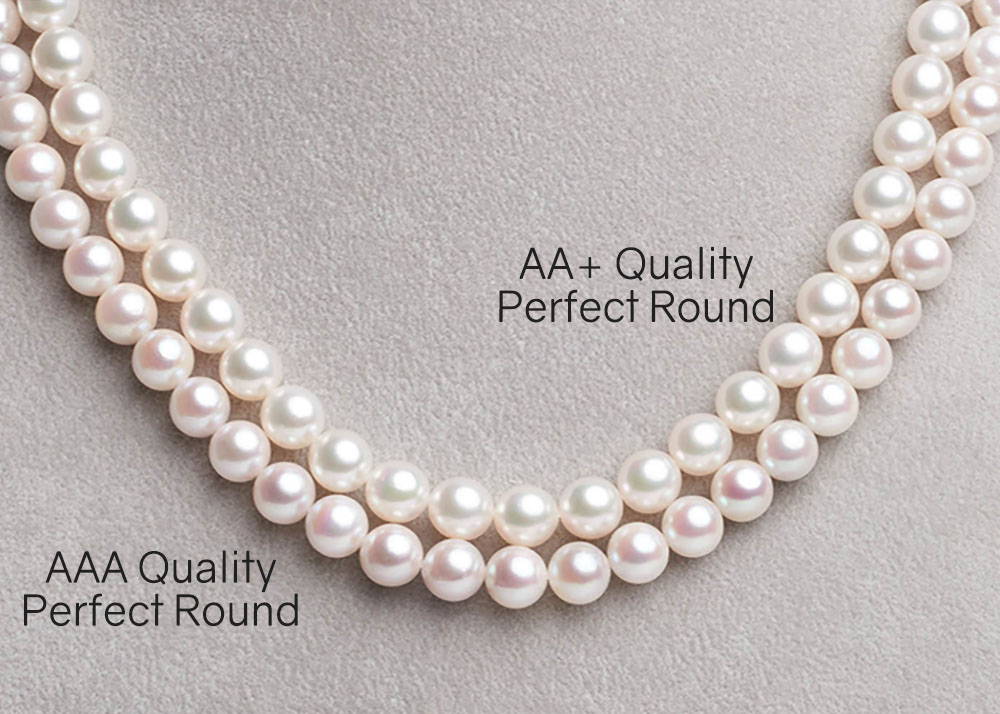Welcome to BAOYUE PEARL, we supply all shapes freshwater pearl with wholesale price, contact us to get a free Quote:

Akoya Pearl Grading – Your Insider’s Guide to Grading Akoya Pearls
This short and sweet guide is a handy reference for learning about Akoya pearls and the A-AAA Grading Scale that Natrualpearlsource.com uses. Featuring visual aids and a systematic breakdown of what exactly you can expect to observe in each grade, this guide will be like having your very own jewelers’ grading hank!
Feel free to read the whole article, or use the links featured in the Table of Contents to skip ahead directly to parts that concern you.
What Makes Akoya Pearls Beautiful?
A smooth, unblemished surface, shimmering iridescent flashes of pink, blue, green and (in the best cases) violet, shimmering over a white primary body color, and of course, their trademark “ball bearing” or mirror-like luster.
These are all the hallmarks of beauty that we expect to see in a high grade Akoya pearl strand.

A cultured saltwater Akoya pearl is the product of a synthesis between humans and nature. A mother of pearl shell bead nucleus is inserted into the host oyster, along with a square of donor mantle tissue from another oyster who has previously borne pearls of high or exceptional value, and the oyster is left to begin secreting around the nucleus, eventually forming a pearl.
The crystalline nacre layers are made up of microscopic aragonite platelets composed of calcium carbonate, and bound together with an organic “glue” of sorts called conchiolin. The aragonite platelets are fairly transparent to slightly tinged in color, able to both reflect and refract light rays striking their surfaces, giving pearls their trademark pearl luster and subtle glow. The tighter and more compact this arrangement of crystal is, the brighter the luster the pearl displays and the greater the amount of orient or iridescence.

This internal structure is what gives pearls their beauty, and makes them worthy of their designation as a precious gemstone. However, because these gems are the result of a biological process, they will never be totally, completely, flawlessly perfect. Mother Nature always leaves her mark! It’s our job as dealers, farmers, designers and consumers to separate out the exceptional from the rest. If you’re intrigued, and want to know more, click here to read more about the 7 Pearl Value Factors.
Now that you know a little bit more about the science behind why and how a pearl is beautiful, we can move on to learning about each pearl grade, what it takes for pearls to qualify and how to buy great pearls.
Akoya A-AAA and Hanadama Pearl Grades

♠ Minimum nacre thickness 0.4mm each side of pearl (0.8mm cumulative depth) or more.
♠ Luster is very sharp with very high rate of reflection.
♠ Easily recognized facial features may be observed in pearl surfaces.
♠ Reflected light sources have very crisp, defined edges.
♠ Blemish rate between 0-5% on each pearl surface.
♠ Hanadama Earrings will set clean.
♠ Hanadama Pearl Strands will appear clean to the eye upon inspection.
♠ Near-perfect matching; little to no variation in color, tone, luster, shape or size.
♠ Read the Ultimate Guide to Hanadama Akoya Pearls for more information.

♠ Visibly thick nacre up to 0.4mm or more.
♠ Luster is very sharp with high rate of reflection.
♠ Easily recognized facial features may be observed in pearl surfaces.
♠ Reflected light sources have crisp, distinctive edges.
♠ Blemish rate is less than 5% on each pearl surface.
♠ AAA Akoya Earrings will set clean.
♠ AAA Akoya Strands will appear clean to the eye upon inspection.
♠ Near-perfect matching; little to no variation in color, tone, luster, shape or size.

♠ Visibly thick nacre up to 0.4mm or more.
♠ Luster is very sharp with high rate of reflection.
♠ Easily recognized facial features may be observed in pearl surfaces.
♠ Reflected light sources have crisp, distinctive edges.
♠ Blemish rate is less than 5% on each pearl surface.
♠ Earrings will set clean.
♠ Strands will appear clean to the eye upon inspection.
♠ Near-perfect matching; little to no variation in color, tone, luster, shape or size.

♠ Thinner nacre; up close inspection may reveal bead nucleus.
♠ Luster is good; fair rate of reflection.
♠ Reflected light sources have blurred, satiny edges.
♠ Blemish rate is less than 15-20% on each pearl surface.
♠ Earrings will not set clean.
♠ Strands will appear slightly spotted to the eye upon inspection.
♠ Good to very good matching; very little variation in color, tone, luster, shape or size.

♠ Thin nacre; up close inspection reveals bead nucleus.
♠ Luster is fair to poor; low rate of reflection.
♠ Pearl appearance may be somewhat chalky.
♠ Reflected light sources have blurry, satiny edges.
♠ Blemish rate is less than 30% on each pearl surface.
♠ Strands will appear spotted to the eye upon inspection.
♠ Good to very good matching; very little variation in color, tone, luster, shape or size.
Akoya Pearl Grade Comparisons
So how does the AA+ vs AAA Quality comparison play out in real life? Which pearl necklace grade should you choose?
The answer is: that depends on what’s important to you in a pearl necklace.

Both the AA+ and AAA Quality Akoya pearl grades are pretty darn close in appearance to the casual observer i.e. someone who’s about a foot or more away from you looking at your pearl necklace shouldn’t be able to tell which is which (all bets are off though if they’ve been trained to look at pearls!).
Both qualities are perfectly round in shape, with excellent matching from pearl to pearl throughout their layouts and their surface inclusions are largely white or colorless, making them not easily visible unless you’re conducting an up-close and personal inspection.
The primary difference between the AA+ Quality and the AAA Quality Akoya pearl is one of luster (and this of course is the same issue when comparing the AAA versus our Hanadama Akoya as well!). The luster on AAA Quality Akoya pearls will be sharper, brighter and have a greater visual ‘depth’ than that of the AA+ grade pearls.
So which grade should you choose?
As a professional in the pearl industry for over a decade, I am a luster and iridescence junkie (full disclosure), and so for my own personal preference, I would choose a smaller-sized, high-quality, high luster pearl necklace over a larger, but less lustrous choice.
That said, there are a ton of customers that go for size over luster (and for good reason!), especially since the two qualities are so close to each other in so many other respects.
Ultimately the answer to this question lies within your budget and your own aesthetics.
Each pear necklace, earring, bracelet and pendant listing on Pure features a drop-down menu on the right side of the page that allows you to customize your pearls to your pearl grade of choice, AA+ or AAA Quality.
Common Blemishes Found on Akoya Pearls
As mentioned earlier, Mother Nature always leaves a mark on her creations.
There are a number of common growth characteristics and surface inclusions you can regularly spot on almost any necklace that are typical of the Akoya pearl type.
These markings are a practical and easy way to:
A. Verify that the pearls are genuine cultured pearls and not man-made imitations, which feature perfect, identical beads throughout an entire layout.
B.Identify that particular set of cultured pearls as yours. As you become familiar with the character of your pearls, you’ll notice that each pearl’s inclusions act as a built-in identification system, marking that strand or pair of earrings as yours and yours alone.
The vast majority of Akoya pearl inclusions are white or colorless in appearance, meaning that they aren’t easily noticed by a casual observer.
Additionally, most Akoya pearl blemishes are fairly small and shallow, covering less than 10-15% of the total surface area of the pearl and so are very unlikely to affect the long-term durability of the gem.

The bracelet layout pictured above is composed of A/AA Quality Akoya pearls that were purchased especially for a custom-design project; these are not a pearl quality I regularly stock in the vaults. That said, the number and variety of blemishes featured in just this short 7-inch layout makes it an excellent example to work with in showcasing the most common Akoya pearl blemishes.
Keep in mind that this particular example is for illustrative purposes only – Pure Pearls does not carry Akoya pearl necklaces or bracelets graded under AA+ Quality.

Akoya Blemishes Close Up:

A) Mottling/Bulleting: this is a faint plating pattern on the pearl’s surface, and considered to be the result of very thick nacre accumulation. As such, this is not considered an inclusion per se, however many do find that this feature can mar the smooth surface of the pearls if found in abundance. A colorless feature, this type of growth characteristic does not impact the beauty of the necklace if found upon up-close inspection occasionally, and does not affect the long-term durability of the pearl.
B) Uneven Accumulation of Nacre: in a perfect world, crystalline nacre is deposited in evenly concentric layers over the bead nucleus during pearl formation … in cases like this, the layering process has been interrupted/disturbed in some way, causing a build-up of nacre in a single area.

C) Clustered Pin Pricks: Tiny pin point indentations in the nacre, clustered together in small groups. If clusters are too numerous, the pearls can have a “chewed” appearance.
D) Blinking: This occurs when the nacre covering the shell bead nucleus is very thin. You can observe “blinking” when examining the pearls up close (at a distance of 6-inches or less) by slowly rotating sections of the strand in front of a strong light source. The internal bead will appear to “flash” a yellow-orange color at you.

E) Single Pin Pricks: Tiny pin point indentations in the nacre, isolated from any others. Tiny, and covered in the same color as the rest of the pearl’s nacre, pin pricks are often only distinguished upon up-close, careful inspection and do not impact the pearl’s durability or beauty.
F) Scaly Spot: This is a clear, colorless inclusion called “uroko” in Japan; it usually indicates some kind of event or growth disturbance while the pearl was being formed inside the oyster.

G) Divot/Flat Spot: Exactly what they sound like: nacreous, flat, circular or oval areas on the pearl’s surface … like the pearl was flattened in one area by a tiny hammer! This is a very common pearl growth feature that, like bulleting, is considered indicative of very thick nacre, and as such also do not count towards a pearl’s grading benchmarks.
H) Blinking: See D.

I) Uneven Nacre Accumulation: See B.
J) Diffused Luster: This will show up wherever you see light reflecting off the surface of the pearls … this is not a pearl blemish, but it is one of the 7 major value factors of pearl grading, and as such merits inclusion here while it’s an easily showcased feature. Notice how the edges of the reflected light sources begin to soften and break up, giving the pearl’s luster a softer, less defined look.
I know that the above image can be kind of terrifying, but again keep in mind that this is for illustrative purposes only; PurePearls.com does not stock Akoya pearls below the AA+ Quality grade (see AA+ Quality breakdown above).
BAOYUE PEARL wholesale natural freshwater pearls All sizes All grade with low prices.
From this article to navigate what pearl size you should buy .
Ready to Learn More about Pearl Grading?
View the rest of our Pearl Grading Guides:





 WhatsApp Code
WhatsApp Code